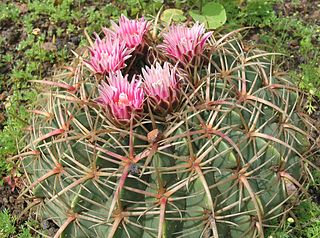
Isolatocereus is a monotypic genus of flowering plant in the family Cactaceae. The only species is Isolatocereus dumortieri that is found in Mexico.

Rapicactus subterraneus, synonym Turbinicarpus subterraneus, is a species of plant in the family Cactaceae. It is endemic to Mexico. Its natural habitat is hot deserts.

Turbinicarpus valdezianus is a species of plant in the family Cactaceae.

Ferocactus glaucescens, the glaucous barrel cactus, is a species of flowering plant in the family Cactaceae, native endemic to México.

Ferocactus echidne is a barrel cactus in the genus Ferocactus. It is found in nature in Mexico. This cactus is known commonly as Sonora barrel, Coville's barrel cactus, Emory's barrel cactus, and traveler's friend. This plant is often sold as a houseplant.

Schoenocaulon is a North American genus of perennial herbaceous flowering plants, ranging from the southern United States to Peru. It is a member of the Melanthiaceae, according to the APG III classification system, and is placed in the tribe Melanthieae. Unlike other genera in the tribe, the flowers are arranged in a spike; depending on the species the flower stalks for each flower are either very short or completely absent. Feathershank is a common name, the medicinally used S. officinale is called Sabadilla.

Stenocereus griseus, also known as the Mexican organ pipe, dagger cactus, pitaya, and pitayo de mayo, is a species of cactus.

Ferocactus pilosus, also known as Mexican lime cactus or Mexican fire barrel, is a species of cactus in North America.

Cochemiea conoidea, common name Texas cone cactus or Chihuahuan beehive, is a species of cactus native to southern United States to central Mexico.

Turbinicarpus valdezianus is a species of plant in the family Cactaceae.

Thelocactus hexaedrophorus is a species of cactus. It is endemic to Mexico.

Thelocactus tulensis is a species of cactus. It is endemic to Mexico.

Stenocereus stellatus is a flowering plant in the family Cactaceae that is found in Oaxaca, Mexico

Ferocactus macrodiscus is a species of cactus in the genus Ferocactus from Guanahuato and Oaxaca States, Mexico.
Quercus affinis is a species of oak native only to Mexico, mostly to the Sierra Madre Oriental pine-oak forests.

Pachycereus weberi is a columnar cactus plant native to Mexico.

Stenocereus treleasei, commonly known as tunillo, is a species of flowering plant in the family Cactaceae, native to Oaxaca in Mexico.

Echinocereus papillosus is a species of cactus native to Texas and Mexico.

Thelocactus conothelos is a species of cactus endemic to Mexico.

Stenocactus obvallatus is a species of cactus native to the deserts of Mexico.




























